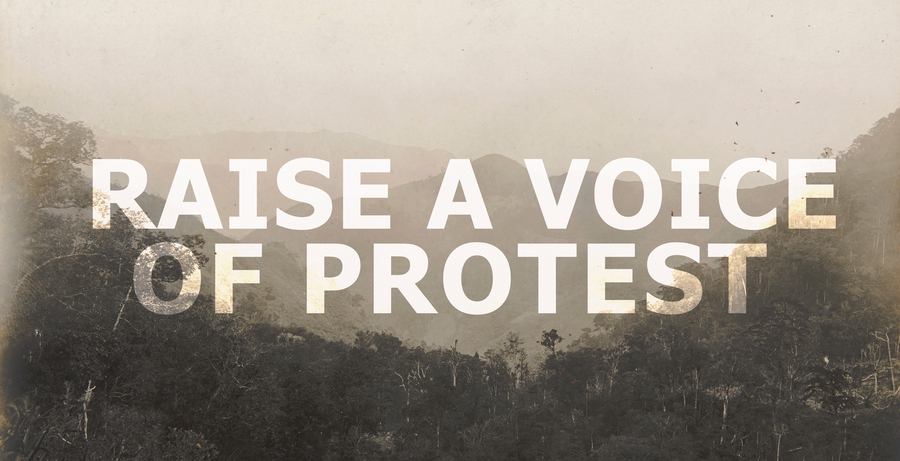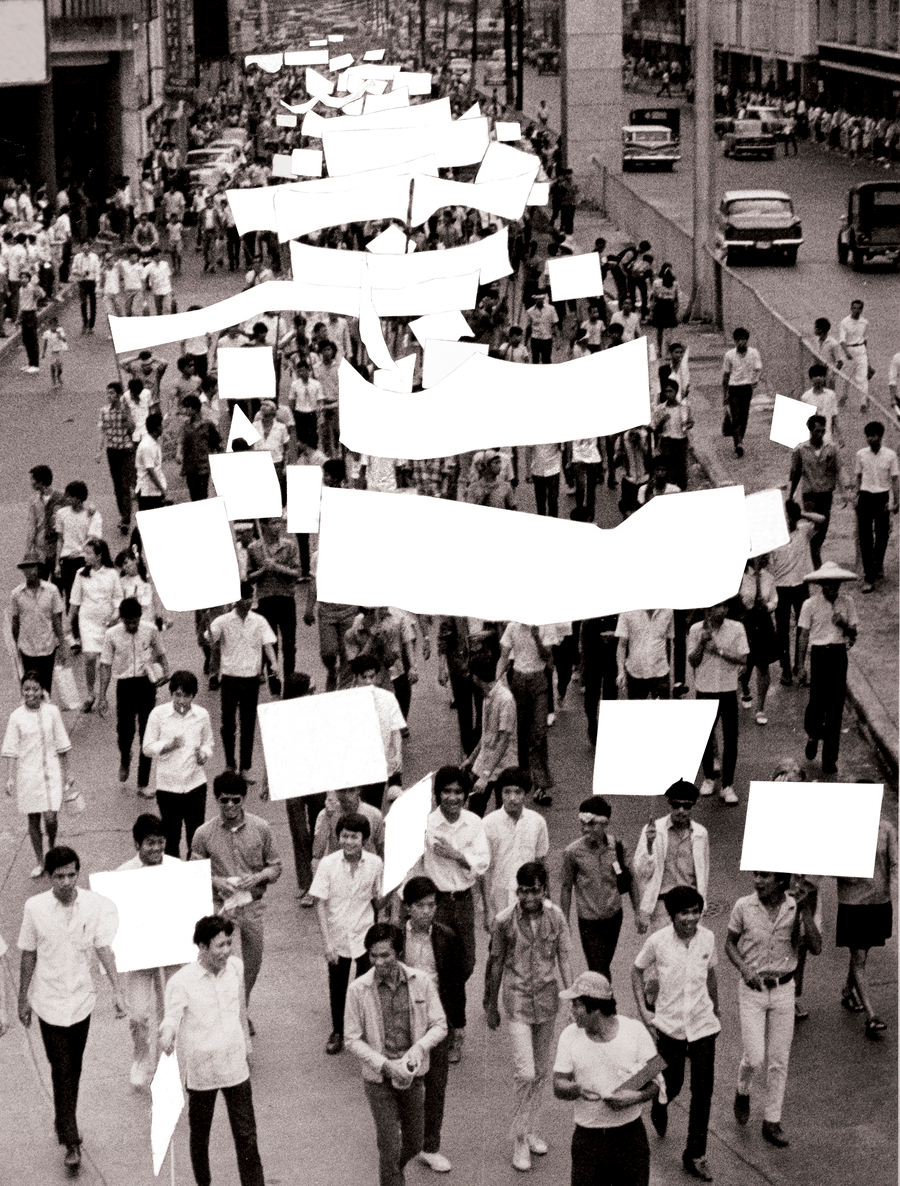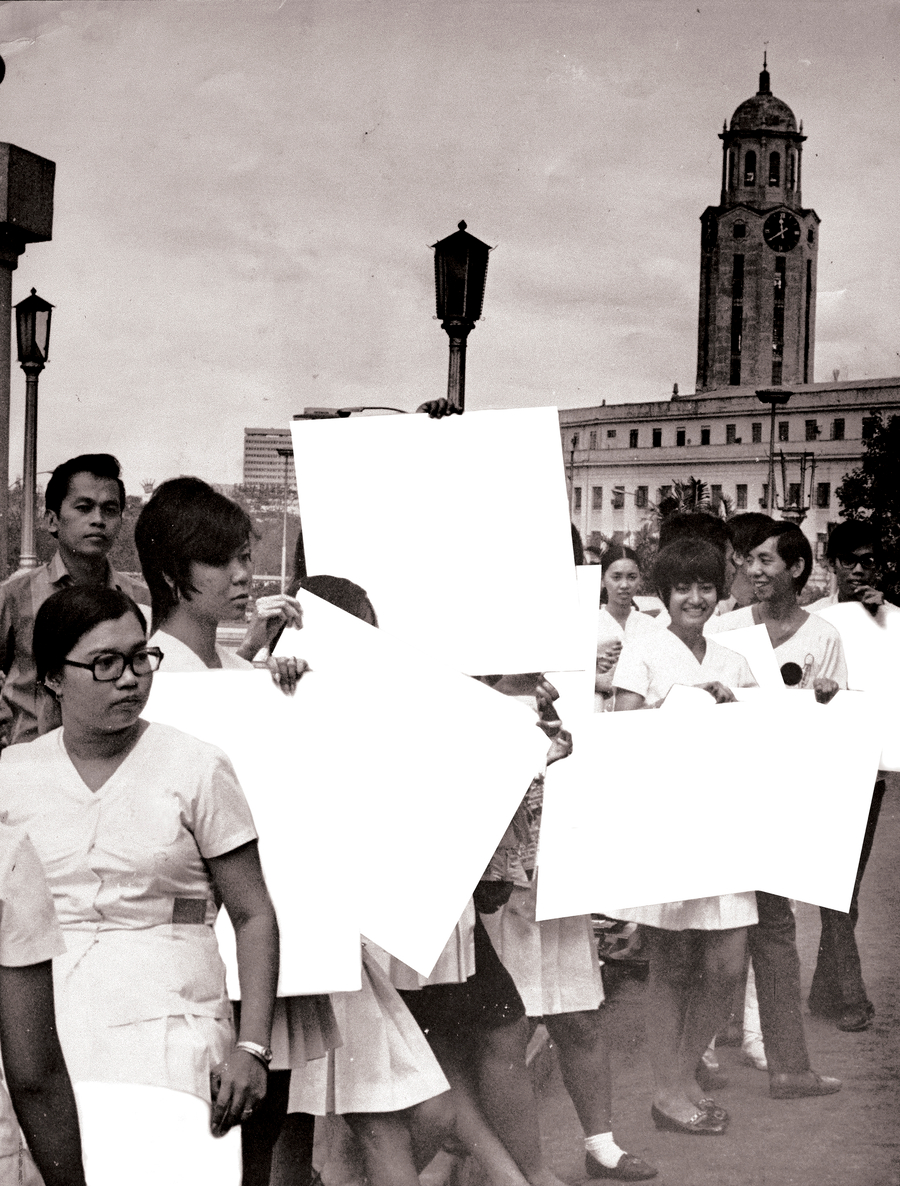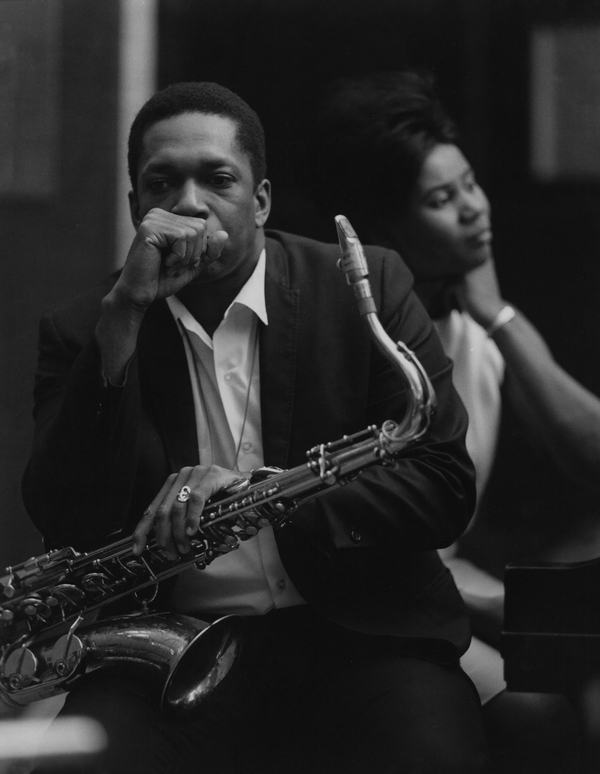 Kiri Dalena, RAISE A VOICE OF PROTEST, Birds of Prey Series, 2025. Original Source Text: Aves De Rapiña, El Renacimiento, October 30, 1908. Original Source Photograph: Dean Conant Worcester, Courtesy Rautenstrauch-Joest-Museum, Köln
Kiri Dalena, RAISE A VOICE OF PROTEST, Birds of Prey Series, 2025. Original Source Text: Aves De Rapiña, El Renacimiento, October 30, 1908. Original Source Photograph: Dean Conant Worcester, Courtesy Rautenstrauch-Joest-Museum, KölnIn her ongoing series Erased Slogans and Birds of Prey, Filipina artist Kiri Dalena has re-worked archival images produced in the Philippines more or less a century apart. Both series convey Filipino histories of the struggles for self-definition, and against silencing. Erased Slogans documents civil resistance against government powers, and Birds of Prey works against the propagandistic colonial lens. The selection presented on billboards in Toronto demonstrates that the projects, begun in 2016 and 2024, respectively, remain globally relevant today, with those in power increasingly attempting to suppress dissenting voices, and cultures worldwide continuing to counter the harm of colonial images.
 Kiri Dalena, ERASED SLOGANS (28 p.31), Erased Slogans Series, 2025. Original Source Photograph: Lopez Museum and Library Archives, Quezon City.
Kiri Dalena, ERASED SLOGANS (28 p.31), Erased Slogans Series, 2025. Original Source Photograph: Lopez Museum and Library Archives, Quezon City.The basis for Erased Slogans is a collection of photographs from the archive of Manila’s López Museum and Library, documenting protests that took place in the Philippines from the 1950s until 1972, the year that then-president Ferdinand Marcos declared martial law. During his twenty-one-year presidency (1965–86), Marcos ruled through military power. In order to quash dissent, his declaration of martial law remained in place until 1981, with the media as Marcos’s first casualty via the issuance of Letter of Instruction No. 1, authorizing the military to take over the assets of major media outlets. Marcos’s crimes and human rights violations included tens of thousands of arbitrary arrests, and thousands tortured, disappeared, and killed. The López collection contains images of students, labourers, peasants, youth, women, Indigenous peoples and more, holding their truths, demands, and hopes aloft. Among the placards that originally read “Equal pay,” “Ang estado ay kasangkapan ng mga naghaharing uri” (“The state is an instrument of the ruling classes”), “We want a home, not a fascist tomb,” and “Freedom to choose,” we find statements that are as relevant as ever. When martial law made protest illegal, activists organized underground. In 1986, the People Power Revolution, a.k.a. EDSA Revolution, saw over a million Filipinos take to the streets and successfully overthrow the Marcos regime. The digitally erased signs in Dalena’s Erased Slogans may be perceived as eerily vacant, defeated even, but integral truths will endure in minds, to emerge as powerful actions.
 Kiri Dalena, ERASED SLOGANS (47 p49), Erased Slogans Series, 2025. Original Source Photograph: Lopez Museum and Library Archives, Quezon City.
Kiri Dalena, ERASED SLOGANS (47 p49), Erased Slogans Series, 2025. Original Source Photograph: Lopez Museum and Library Archives, Quezon City.In Birds of Prey, Dalena works with images from the collection of the Rautenstrauch-Joest Museum (RJM) in Cologne, Germany. At least 16,000 images were taken or commissioned by Dean Conant Worcester, Secretary of the Interior (1901–13) for the U.S. colonial government in the Philippines (1898–1946). Sometime in 1906, Georg Küppers-Loosen, a Cologne merchant staying in Manila, purchased thousands of the photographs, and following his death in 1911, they were donated to the RJM. Worcester had been tasked by the U.S. government with compiling the collection, with the directive of portraying the Filipino people as incapable of self-governance. Employing colonial, pseudoscientific methods, Worcester set in motion a gaze that would be racializing at best, dehumanizing at worst. A zoologist and ornithologist prior to his Secretariat position, Worcester catalogued the images similarly to an index of animals. The main subjects of his photographs were people, with images of objects being less common, and landscape shots a rarity, limited mostly to the North Luzon region of the diverse 7,641–island archipelago. Worcester was sure to capture front and side perspectives of the subjects’ physiognomy (both nude and clothed), details of dress and hairstyles—the style of anthropometric documentation commonly misused for racial classification. While the Secretary’s attention to the landscape was meagre, it didn’t prevent him from positioning himself as an expert, publishing the two-volume The Philippines, Past and Present (1914), claiming to have civilized a forsaken archipelago and its primitive people.
 Kiri Dalena, BORN TO EAT AND DEVOUR, Birds of Prey Series, 2025. Original Source Text: Aves De Rapiña, El Renacimiento, October 30, 1908. Original Source Photograph: Dean Conant Worcester, Courtesy Rautenstrauch-Joest-Museum, Köln
Kiri Dalena, BORN TO EAT AND DEVOUR, Birds of Prey Series, 2025. Original Source Text: Aves De Rapiña, El Renacimiento, October 30, 1908. Original Source Photograph: Dean Conant Worcester, Courtesy Rautenstrauch-Joest-Museum, KölnThe reference to birds in Dalena’s title refers both to Worcester’s inappropriately applied ornithologist’s methodology and to a 1908 anti-imperialist editorial titled “Aves de Rapiña” (“Birds of Prey”) published in the Filipino newspaper El Renacimiento. Although the article named no names, Worcester was triggered by the recognition of his own actions. Patently rebuffing its ugly truths, Worcester and the colonial government went to great efforts to disassociate themselves from the essay’s claims. Attacking through legal channels, the U.S. filed criminal libel charges, and Worcester filed his own civil suit for damages. The newspaper went out of business.
 Kiri Dalena, WHO WILL DETAIN THEM?, Birds of Prey Series, 2025. Original Source Text: Aves De Rapiña, El Renacimiento, October 30, 1908. Original Source Photograph: Dean Conant Worcester, Courtesy Rautenstrauch-Joest-Museum, Köln
Kiri Dalena, WHO WILL DETAIN THEM?, Birds of Prey Series, 2025. Original Source Text: Aves De Rapiña, El Renacimiento, October 30, 1908. Original Source Photograph: Dean Conant Worcester, Courtesy Rautenstrauch-Joest-Museum, Köln Kiri Dalena, TRIUMPH IN THE PLUNDER, Birds of Prey Series, 2025. Original Source Text: Aves De Rapiña, El Renacimiento, October 30, 1908. Original Source Photograph: Dean Conant Worcester, Courtesy Rautenstrauch-Joest-Museum, Köln
Kiri Dalena, TRIUMPH IN THE PLUNDER, Birds of Prey Series, 2025. Original Source Text: Aves De Rapiña, El Renacimiento, October 30, 1908. Original Source Photograph: Dean Conant Worcester, Courtesy Rautenstrauch-Joest-Museum, Köln BORN TO EAT AND DEVOUR
WHO WILL DETAIN THEM?
TRIUMPH IN THE PLUNDER
RAISE A VOICE OF PROTEST
With texts excerpted from “Aves de Rapiña,” Dalena suggests a cycle—when insatiable greed appears, so will those who hold it to account. The artist inscribes El Renacimiento’s words against images of the landscape, rather than the ethnographic portraits, refusing the reification of Worcester’s portrayal of Filipinos. In her engagement with the RJM collection, Dalena has troubled the archive with the questions: “How should we regard and handle materials borne of and embedded with violence? How do we take into account those who are responsible for the violence? Will rewriting these photographs in another form, to evoke the ‘semblance of resistance’ … be the way to do it?” Erased Slogans indicates how Dalena’s politics were formed, around events of the Marcos era, recent enough to imprint heavily on her generation. In 2020, invited to conduct research at the RJM, Dalena was unprepared for the experience of being “fully possessed” by the images that would become part of Birds of Prey.The pairing of these two series, begun approximately a decade apart, exemplifythe artist’s career-long preoccupation with human rights, equality and justice, part of which encompassesexposing the recurring tropes of the powerful, intheir attempts to control narrative.
Presented by CONTACT Photography Festival. Supported by PATTISON Outdoor Advertising
Curated by Su-Ying Lee











































